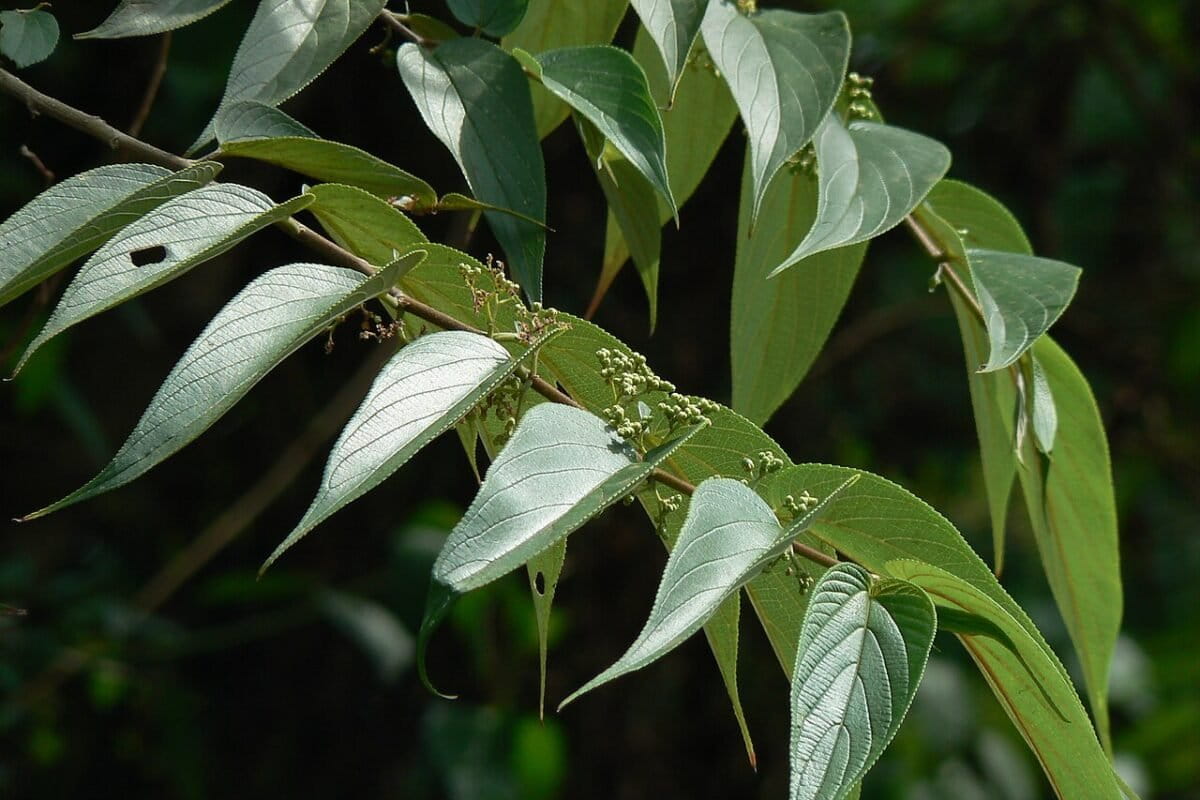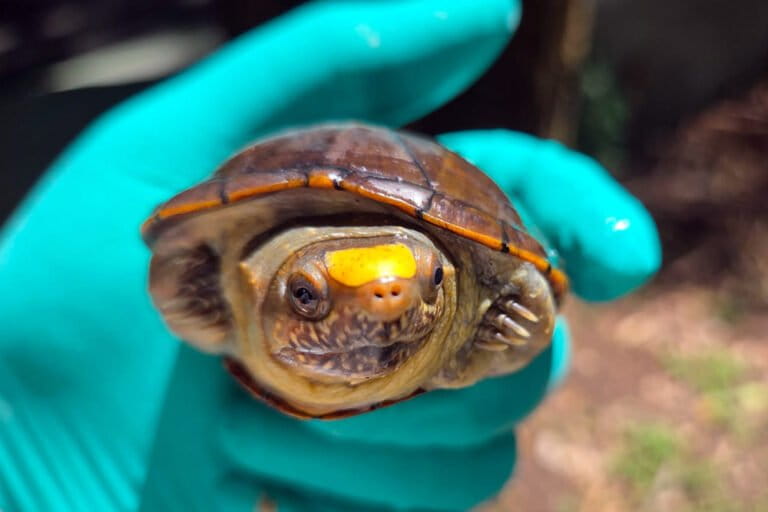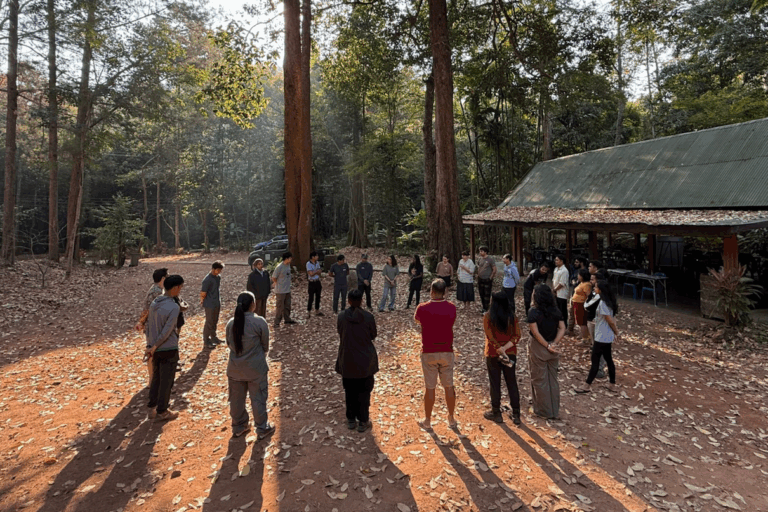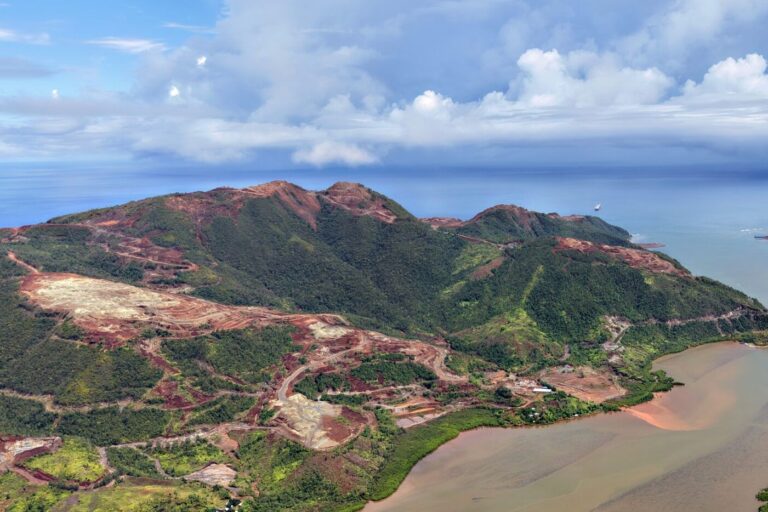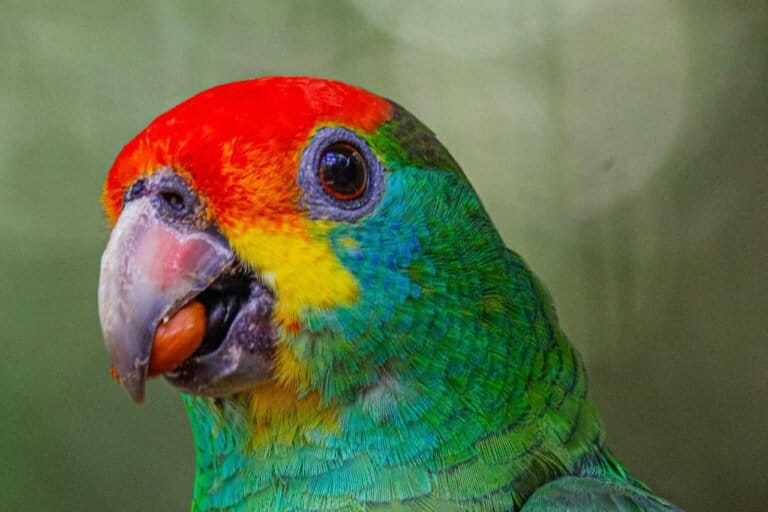New Zealand’s Department of Conservation (DOC) is facing a backlash over plans to aerially drop a controversial poison, known as 1080, over the habitat of two endangered, prehistoric, and truly bizarre frog species, Archey’s and Hochsetter’s frogs, on Mount Moehau. Used in New Zealand to kill populations of invasive mammals, such as rats and the Australian long-tailed possum, 1080 has become an increasingly emotive issue in New Zealand, not just splitting the government and environmentalists, but environmental groups among themselves. Critics allege that the poison, for which there is no antidote, decimates local animals as well as invasives, while proponents say the drops are the best way to control invasive mammals that kill endangered species like birds and frogs and may spread bovine tuberculosis (TB).
The Potent Insecticide Turned Mammal-Killer
.600.jpg)
An invasive species in New Zealand, the Australian long-tailed possum may be a carrier of TB. Photo by: Brisbane City Council.
Although 1080 is not widely known outside of New Zealand, there it has become infamous. 1080 was first produced in the 1940s by synthetically replicating sodium monofluoroacetate, a natural substance that plants use to deter herbivores. Initially, it was developed as an insecticide.
“New Zealand pioneered the industry of aerial […] pesticide application after World War II when returning soldiers were gifted ‘bush blocks’ free in exchange for clearing them of native forest to create farms. This was done using World War II technologies and the toxins which were developed at that time,” Paul Tucker, the director of Friends of the Earth New Zealand, told mongabay.com, adding that “I am afraid the warnings of Rachel Carson at the time had little effect in rural New Zealand!”
Today New Zealand, which uses between 80-90 percent of the 1080 consumed worldwide, employs it against invasive mammals, because all mammals (including humans) are highly vulnerable to the poison. The DOC laces carrot and cereal pieces with 1080 and then aerially drops them over the target region, hoping to kill rats, stoats, and possums en-masse. However, importantly, 1080 biodegrades in the environment over time, essentially becoming harmless. Still, the chemical is ranked by the World Health Organization (WHO) at the top of toxicity levels, and most nations have banned its use. When the U.S. EPA curtailed the use of 1080 in 1985 it listed as one of its reasons, “a significant reduction in populations of nontarget organisms and fatalities to endangered species.”
One of the main concerns over the current drop is that it could harm two “nontarget” endangered and distinct frog species found on Moehau Mountain.
“Moehau is the highest mountain on the Coromandel, a peninsula east of the Auckland area that consists of more than 50 percent State Forest Parks and the like,” Pat Whiting-O’Keefe, a chemist who lives at the foot of the mountains, says. “It is at the tip of the peninsula and is covered by a beautiful native forest containing among other things the only known population of Archey’s frog.”
The Impact of 1080 on Frogs? No One Really Knows
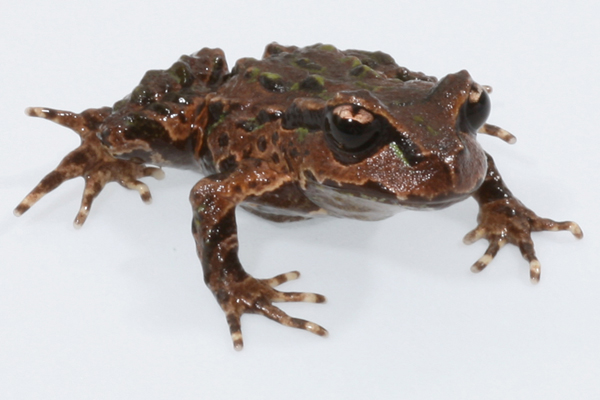
Archey’s frog, a prehistoric survivor that is facing extinction. Photo by: Phil Bishop.
Of all the frogs in the world, the EDGE program (Evolutionary Distinct and Globally Endangered) has listed Archey’s frog as the world’s top oddball. Considered a “living fossil,” the species looks almost exactly the same as amphibian fossils from 150-200 million years ago. Archey’s frog is distinguished by additional vertebrae, a lack of ear drums (it is believed to communicate via scent), and muscles for wagging a tail, but no tail. The muscles likely remain from an epoch when Archey’s ancestors still sported tails. In addition eggs laid by Archey’s frogs do not hatch tadpoles, but fully-formed froglets. Despite being an outlier in today’s amphibians, Archey’s frog is quite attractive with brown skin mottled by black-and-green designs, and sharp black eyes. No one knows exactly how many Archey’s frogs are left, but the population has fallen in places by at least 80 percent in just ten years. The region is also home to Hochstetter’s frog (Leiopelma hochstetteri), which is number 38 on the EDGE Amphibian list. Classified as Vulnerable, the Hochstetter’s frog is also an ancient frog, closely related to Archey’s but with a larger population. Both of these species are in the Leiopelmatidae family, which comprises just four species all evolutionary throwbacks from New Zealand. Losing any member of the Leiopelmatidae family would be losing a window into the past, but to date little is known about the impacts of 1080 on these frogs.
“Since aerial 1080 has not been used on Moehau before (wide protests prevented it previously), we have no evidence regarding Archey’s frog. And we are not aware of any studies on Hochstetter’s frog. So the real risk is unknown,” Whiting-O’Keefe says.
The government appears to agree with Whiting-OKeefe’s at least on one point.
“[We] don’t know if 1080 has any impact on the frogs,” the spokesman for the DOC, Rorya Newsam, stated recently.
Although instantly lethal to mammals—with no antidote—1080 is considered less dangerous to amphibians, however that doesn’t mean it couldn’t theoretically have a devastating effect on populations. Still despite such lingering questions, the drop remains scheduled.
“There is a planned 1080 drop on Moehau, up on the Coromandel, but that’s been on the cards for a long time,” Newsam says. “That’s well-documented.”
In response to criticism over the planned drop, the Waikato Conservancy Office with the DOC has released a statement noting that, “While scientific research on the impact of 1080 on our native frog species is not extensive compared with data available on other species, it is a fact that aerial 1080 has been used, over the past 20 years, in three areas of known frog habitat, namely the Hunua Ranges (Hochstetter’s), Whareorino (Hochstetter’s and Archey’s) and the Coromandel Peninsula (both species).”
In fact, the DOC argues that 1080 not only hasn’t hurt these populations, but actually benefited them by poisoning rat and stoat populations, which are known to prey on the frogs. According to the DOC, whatever risk 1080 may pose to frogs, it is far outweighed by the poison’s efficacy in mammal-killing. Such arguments are backed by some environmental groups and scientists as well. Forest & Bird, an influential conservation organization in New Zealand, adamantly supports the use of 1080; while Phil Bishop, an expert on Archey’s and Hochstetter’s frogs, also cautiously agrees.
“While in principle I am not an advocate of any kind of poisons being used in the environment—especially ones where we are not 100 percent sure of all the side effects that may happen when existing, albeit human induced, food chains are disrupted,” he told mongabay.com, “from a frog conservationists point of view and with the available documented information we have at hand, the 1080 drop seems to be beneficial for the native frogs in New Zealand.”
The Plot Thickens

Hochstetter’s frog, considered Vulnerable by the IUCN Red List. Photo by: Phil Bishop.
But even when researchers have monitored frog populations before-and-after 1080 drops, the findings are prone to contention.
“I was an official ‘independent observer’ to a monitoring operation when Hochstetter’s were first dropped [with 1080] over in the early nineties [at Hunua],” Paul Tucker says. “After the drop 50 percent of frogs ‘disappeared’ from the main monitoring site. No reasonable explanation was ever given by the Council and University team involved.”
But the DOC statement counters that, “No evidence was found to suggest the operation had any impact whatsoever on the frog population. One frog found dead after the operation later tested negative for 1080 poisoning.”
Still Tucker, who says the decline was verified by several researchers, calls Hunua a “watershed” moment.
“Prior to the Hunua drop, regulations did not allow the aerial dropping of 1080 directly into smaller streams,” he continues. “However these regulations were changed in 1994 so that 1080 could be dropped into any stream smaller than 3 meters wide and 1 meter deep. This facilitated aerial 1080 to be dropped in native frog habitats ever since then native frog populations have dropped by 90 percent.”
Tucker believes that when the 1080-laced pellets are dropped in forests and streams, flying insects—the frog’s prey—feed on them. The frogs, therefore, consume 1080 when they eat their prey.
“A basic 5 gram pellet is calculated to kill a possum however this is enough 1080 to kill 70 Archey’s frogs,” Tucker says, adding that “the pellets used at Hunua contained enough 1080 to kill to 150 frogs each.”
But Phil Bishop, with the University of Otago in New Zealand, says that from his perspective “there has been no direct evidence that the use of 1080 has any harmful effect on the native Leiopelmatid frogs.”
As proof, he cites several examples in which frog populations persisted after 1080 was dropped.
“Last year DOC started a controlled experiment in the Whareorino forest and dropped 1080 in an area where the frogs (Archey’s and Hochstetter’s) had been well-monitored and excluded it from another well-monitored area,” he notes. “The data has yet to be fully analyzed as its still early days and still being collected, but the results are looking good and the frogs seem to be doing as well if not better in the area that received the 1080 drop.”
Like the DOC, Bishop says that in fact 1080 may be helpful for the frogs in the long run.
“In an earlier study by DOC in the same area involving trapping rats, they showed that the rats played a significant role in keeping the frog numbers low and when you removed the rats the frogs recovered. It is likely that the benefits—to the frogs, by reducing their introduced predators—outweigh any harm that might be caused by a 1080 drop.”
Des Williams, a Communications and Engagement Advisor with the DOC told mongabay.com, that the department was going ahead with the 1080 drop on Moehau Mountain, because “We are confident in the robustness of the information we do have from monitoring through previous operations that the up-coming operations on the Coromandel are not going to be detrimental to the frogs.”
Disease? Or Pesticide Plus Disease
But if 1080 is not to blame for declines in New Zealand’s native frogs, what is? A study in Biological Conservation looking at a sudden decline in Archey’s frog found that a deadly frog fungal disease, known as chytridiomycosis, was the most likely cause. The authors concluded that since the decline occurred both inside and outside 1080 drop sites, it was also unlikely the pesticide was the cause.
That’s not the end of the debate, however, since other research finds that the truth may be less clear-cut and 1080 may still be problematic.
“Ten years ago, as I found many Archey’s frogs dying in the Coromandel, I was surprised to discover that they were victims not of chytrid fungus but rather of a variety of other pathogens,” Bruce Waldman an expert on New Zealand’s frogs with Lincoln University told mongabay.com. “In our captive facilities, many sick frogs recovered. So something in their natural environment seems to be harming them. Pesticides, such as 1080, might be responsible, but we just do not know.”
According to Waldman, 1080 could be causing sublethal impacts on the frogs. In other words, while 1080 may not kill the frogs outright, it eventually leads to longterm harm, resulting in population declines such as those seen in Archey’s frogs in recent decades.
“Chronic exposure to low sublethal doses of some pesticides can chemically castrate animals or suppress their immune system,” he explains. “Previous studies have demonstrated that chronic exposure to 1080 can lead to cumulative physiological effects, for example, on circulatory system function, and that 1080 can seriously impair nervous system function in amphibians.”
Dwelling in moist soils, Archey’s frogs may contact 1080 long after its been dropped, according to Waldman, since the chemical doesn’t breakdown quickly in all environments.
“In some conditions, 1080 persists in solution for long periods of time,” he warns, adding that, “If 1080 persists in the frogs’ environment, chronic effects on them are entirely possible.”
Studies on pesticides worldwide has long focused on immediate, lethal impacts, but a growing body of research is showing that sublethal impacts of many pesticides may be doing considerable harm to wildlife and humans around the globe.
Controversy Beyond Frogs
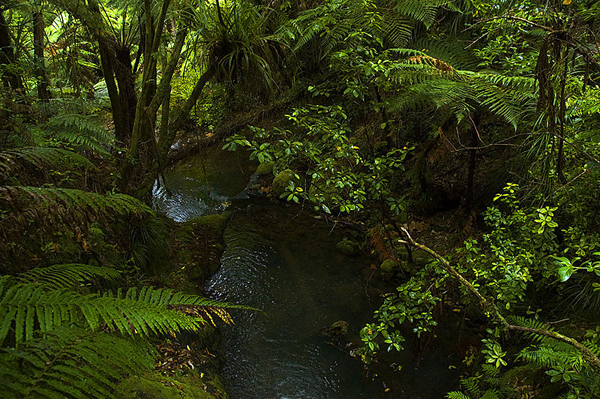
Rainforest on Coromandel Peninsula. Photo by: James Shook.
Of course, the uproar goes well-beyond the frogs. Research has documented that native birds have also been killed by 1080 in the past including a drop in 2008 that left seven keas dead out of a local population of 17. Keas (Nestor notabilis) are large indigenous parrots that are currently listed as Vulnerable by the IUCN Red List. Numerous other bird species have been recorded succumbing to 1080 bait.
“Yes, there have been casualties,” Williams admits, “but these are greatly outweighed by the increased breeding and fledging success following the removal of possums, rats and stoats that prey on eggs and chicks in the nest. Changes in techniques over the past 20 years have greatly minimized impact on bird species.”
However, critics allege that DOC research on 1080 drops are often short-term, lacking in scientific rigor, and misrepresented to the media.
“Unfortunately DOC has gained a reputation for ignoring, avoiding and covering up the effects of aerial poisoning on non target fragile native species,” Paul Tucker says.
Meanwhile, locals have also expressed fear for their livestock and pets—1080 is especially lethal to dogs.
“There are perhaps 50 permanent residents on our side of the mountain (i.e. the northeast side). Many if not most residents of the Coromandel are strong environmentalists and conservationists,” Whiting-O’Keefe says. “Those of us who live in the rural areas and who own land containing blocks of native forest work hard to protect our heritage.”
In February, the Coromandel Community Board came out officially against the proposed drop.
But Des Williams says, “Most locals are actually very supportive of the operation.” She points to two investigations—one in 2007 by the Environmental Risk Management Authority (ERMA) and another in 2011 by the Parliamentary Commissioner for the Environment—that have cleared 1080 for use.
“Both agencies have supported the continued use of 1080 in appropriate circumstances (e.g., rugged back country where trapping and other techniques are physically and financially unviable),” he says.
Why 1080?

Sign in area of 1080 drop. Photo by: Greg O’Beirne.
A final question worth asking, however, is why aerial drops of 1080 at all? Why not other, less controversial methods of pest control used worldwide such as trapping, hunting, or more targeted use of poison? Proponents of 1080 point to New Zealand’s ecological history as a bird-haven.
“New Zealand is unique as we have only two native species of land mammals—the short tailed and the long tailed bats. Everywhere else in the
world native mammals are an integral and important part of the ecosystem, so the use of 1080—which is particularly effective against mammals —is restricted,” reads a statement from Forest & Bird on their website.
However the argument that New Zealand is unique (and thus requires a unique solution) falls flat when one considers that many islands in the Pacific have the exact same ecological problem as New Zealand: few (if any) native mammal species; a large complement of vulnerable native birds; and a major problem with invasive mammals like rats. But none of these Pacific Islands have turned to 1080 as a solution. In fact, by using between 80-90 percent of the world’s 1080 annually, New Zealand stands alone among island countries with its strategy of containing invasive mammals. A strategy critics say is not working even after decades of use, since invasive mammals appear as abundant as ever. In fact, a 2007 study in the New Zealand Journal of Ecology found that even if 90 percent of an area’s rats are killed, the rodents can recover their old numbers within just six months.
Paul Tucker alleges that one of the reasons for New Zealand’s focus on the poison may be governmental self-interest.
“The New Zealand Government owns the factory which produces the poisoned 1080 pellets (they also manufacture brodifacoum pellets for aerial use) and they require all regional councils to use them. ‘Pest Control’ has become big business with an amazing budget.”
Despite the criticism and controversy, the DOC has stated that it intends to go ahead with the drop shortly, convinced that it will help save native frogs and birds from eradication by invasive mammals. But if the drop does occur, its actual impacts will likely remain obfuscated by limited studies and polarizing arguments over whatever findings do come to light. Even now, decades of research—allegedly patchy, poor, and overseen by DOC—has failed to convince many in New Zealand of the utility and safety of 1080.
“Invasive pest mammals comprise an obvious threat to New Zealand biodiversity. But to dismiss out of hand suggestions that 1080 might harm native species through sublethal physiological effects and thereby contribute to long-term population declines is just foolish,” Bruce Waldman says. “Until we know why Archey’s frogs are dying in Coromandel forests, we cannot just proceed on the assumption that dangers that they incur by exposure to 1080 drops have been sufficiently mitigated. To do proper studies on 1080’s effects on frogs would not be difficult, so why have they not been done?”
Related articles
Whale only known from bones washes up on beach in New Zealand

(11/05/2012) In 2010, a whale mother and male calf were found dead on Opape Beach in New Zealand. Although clearly in the beaked whale family—the most mysterious marine mammal family—scientists thought the pair were relatively well-known Gray’s beaked whales (Mesoplodon grayi). That is until DNA findings told a shocking story: the mother and calf were actually spade-toothed beaked whales (Mesoplodon traversii), a species no one had ever seen before as anything more than a pile of bones.
Forget-me-not: two new flowers discovered in New Zealand gravely endangered
(08/23/2012) New Zealand scientists have discovered two new species of forget-me-nots (flowers in the genus Mytosis), both of which are believed to be endangered. Discovered in Kahurangi National Park on the South Island, the new species highlight the diversity of the tiny flowers in New Zealand.
Maui’s dolphins still in danger of extinction despite New Zealand’s protective measures
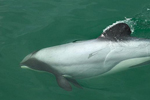
(08/07/2012) The New Zealand government’s recent efforts to protect the world’s smallest dolphin have come under scrutiny from various conservation organizations at the 64th meeting of the International Whaling Commission (IWC). There are only 55 Maui dolphins (Cephalorhynchus hectori maui) now found on the west coast of New Zealand’s North Island, less than half the 2005 population with numbers continuing to decline. Less than 20 of the remaining Maui’s are breeding females and their slow reproductive rates make it difficult to increase their numbers when faced with an even bigger danger: fishing nets.
New species threatened by mining dubbed the ‘Avatar moth’
(06/19/2012) A new species of moth has been named after one of the world’s most popular movie blockbusters: Avatar. Discovered on New Zealand’s Denniston Plateau during a biodiversity survey by local NGO Forest & Bird this March, the new moth species is imperiled by plans for a coal mine on the plateau. The name—Avatar moth (Arctesthes avatar)—was chosen by its discoverers from a list of almost 100 entries by the public.
World’s smallest dolphin: only 55 left, but continue to drown in nets
(03/22/2012) The world’s smallest dolphin is also the closest to extinction. New Zealand government figures show that Maui’s dolphin (Cephalorhynchus hectori maui) are down to just 55 mature individuals, falling from 111 in 2005. The small cetaceans, measuring up to 1.7 meters (5.5 feet), are imperiled due to drowning in gillnets with the most recent death by a fisherman’s net occurring in January.
New Zealand’s log exports to China surging
(10/27/2011) New Zealand’s log exports to China are surging, reports the Wood Resource Quarterly.
Photos: New Zealand oil disaster kills over 1200 birds to date
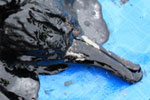
(10/16/2011) According to the New Zealand government an oil spill from a grounded container ship in the Bay of Plenty has killed 1,250 seabirds with hundreds of others in rescue centers. However, conservationists say the avian death-toll is far higher with most contaminated birds simply vanishing in the sea. “The number of birds being found washed up on the beaches will be a very small proportion of the birds being affected,” explained Karen Baird, Seabird Conservation Advocate with NGO Forest & Bird.
Bird-killing oil spill New Zealand’s ‘worst environmental disaster’

(10/12/2011) An oil spill from a grounded container ship in New Zealand’s Bay of Plenty is threatening to worsen as authorities fear the ship is breaking up. Already, 350 tons of oil from the ship, the MV Rena, has leaked out with some reaching nearby beaches including a popular holiday spot, Papamoa Beach. To date the spill has killed over 200 birds, including little blue penguins, shags, petrels, albatrosses and plovers. If the ship breaks up and sinks, authorities fear it could release its remaining 1,400 tons into the marine ecosystem.





